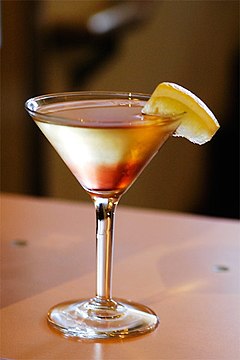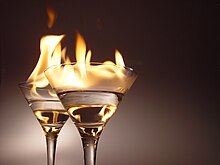Cocktail

When used as a word to refer to mixed drinks generally, cocktail may mean any kind of alcoholic mixed drink that contains two or more ingredients. As generally understood today, a cocktail requires at least one alcoholic component—typically a distilled spirit, although beer and wine are permissible—and one sweet component; it may also contain a souring or bittering ingredient.[1]
Traditionally cocktails were a mixture of spirits, sugar, water, and bitters.[2]
Most types of mixed drinks today are called cocktails, and they will usually contain one or more kinds of spirit and one or more mixers, such as soda or fruit juice. Additional ingredients may be sugar, honey, milk, cream, and various herbs.[3]
History
The origin of the word cocktail is disputed.
The first recorded use of the word cocktail not referring to a horse is found in The Morning Post and Gazetteer in London, England on March 20, 1798:[4]
Mr. Pitt,
two petit vers of “L’huile de Venus”
Ditto, one of “perfeit amour”
Ditto, “cock-tail” (vulgarly called ginger)
The Oxford English dictionary cites the word as originating in the U.S. The first recorded use of the word cocktail as a beverage (possibly non-alcoholic) in the United States appears in The Farmer's Cabinet on April 28, 1803:[5]
Drank a glass of cocktail—excellent for the head...Call'd at the Doct's. found Burnham—he looked very wise—drank another glass of cocktail.

The first definition of cocktail known to be an alcoholic beverage appeared in the May 13, 1806, edition of The Balance and Columbian Repository, a publication in Hudson, New York, in which an answer was provided to the question, "What is a cocktail?". The editor Harry Croswell replied:
Cock-tail is a stimulating liquor, composed of spirits of any kind, sugar, water, and bitters—it is vulgarly called bittered sling, and is supposed to be an excellent electioneering potion, inasmuch as it renders the heart stout and bold, at the same time that it fuddles the head. It is said, also to be of great use to a democratic candidate: because a person, having swallowed a glass of it, is ready to swallow any thing else.[6]
Compare the ingredients listed (spirits, sugar, water, and bitters) with the ingredients of an Old Fashioned,[7] which originated as a term used by late 19th century bar patrons to distinguish cocktails made the “old-fashioned” way from newer, more complex cocktails.[8]
The first publication of a bartenders' guide which included cocktail recipes was in 1862 — How to Mix Drinks; or, The Bon Vivant's Companion, by "Professor" Jerry Thomas. In addition to listings of recipes for Punches, Sours, Slings, Cobblers, Shrubs, Toddies, Flips, and a variety of other types of mixed drinks were 10 recipes for drinks referred to as "Cocktails". A key ingredient which differentiated "cocktails" from other drinks in this compendium was the use of bitters as an ingredient. Mixed drinks popular today that conform to this original meaning of "cocktail" include the Old Fashioned Whiskey Cocktail, the Sazerac Cocktail, and the Manhattan Cocktail.

The first "cocktail party" ever thrown was allegedly by Mrs. Julius S. Walsh Jr. of St. Louis, Missouri, in May 1917. Mrs. Walsh invited 50 guests to her home at noon on a Sunday. The party lasted an hour, until lunch was served at 1 pm. The site of this first cocktail party still stands. In 1924, the Roman Catholic Archdiocese of St. Louis bought the Walsh mansion at 4510 Lindell Boulevard, and it has served as the local archbishop's residence ever since.[9]
During Prohibition in the United States (1919–1933), when alcoholic beverages were illegal, cocktails were still consumed illegally in establishments known as speakeasies. The quality of liquor available during Prohibition was much worse than previously.[10] There was a shift from whiskey to gin, which does not require aging and is therefore easier to produce illicitly.[11] Honey, fruit juices, and other flavorings served to mask the foul taste of the inferior liquors. Sweet cocktails were easier to drink quickly, an important consideration when the establishment might be raided at any moment.
Cocktails became less popular in the late 1960s and through the 1970s, until resurging in the 1980s with vodka often substituting the original gin in drinks such as the martini. Traditional cocktails began to make a comeback in the 2000s[12]and by the mid-2000s there was a renaissance of cocktail culture in a style typically referred to as Mixology that draws on traditional cocktails for inspiration but utilizes novel ingredients and often complex flavors.[13]
See also
- List of cocktails
- List of beverages
- IBA Official Cocktail
- Cocktail (1988 film)
- Cocktail (2010 film)
- Cocktail (2012 film)
- Cocktail glass
- Cocktail party
- Cocktail shaker
- Flaming beverage
- The Fine Art of Mixing Drinks – A classic cocktail book
References
- ^ OED cocktail, n.
- ^ Thomas, Jerry (1862). How To Mix Drinks.
- ^ DeGroff, Dale (2002). The Craft of the Cocktail. Potter.
- ^ Jared Brown & Anistatia Miller (2009). Spirituous Journey: A History of Drink, Book Two. Mixellany Limited. ISBN 0-9760937-9-0.
- ^ David Wondrich (2007). Imbibe!: From Absinthe Cocktail to Whiskey Smash, a Salute in Stories and Drinks to "Professor" Jerry Thomas, Pioneer of the American Bar. Perigee Trade. ISBN 0-399-53287-0.
- ^ The Balance and Columbian Repository, May 13, 1806, No. 19, Vol. V, page 146
- ^ Kappeler (1895). Modern American Drinks: How to Mix and Serve All Kinds of Cups and Drinks.
- ^ Wondrich, David (2007). Imbibe! From Absinthe Cocktail to Whiskey Smash, a Salute in Stories and Drinks to 'Professor' Jerry Thomas, Pioneer of the American Bar. Perigee. ISBN 978-0-399-53287-0.
- ^ Felten, Eric (October 6, 2007). "St. Louis -- Party Central". The Wall Street Journal.
- ^ Regan, Gary (2003). The Joy of Mixology. Potter.
- ^ Eric Felton (November 28, 2008). "Celebrating Cinco de Drinko". The Wall Street Journal.
- ^ Anthony Dias Blue (2004). The Complete Book of Spirits. Harper Collins. p. 58.
- ^ Jared Brown (2007). Mixologist: The Journal of the American Cocktail. Ready Writers Publishing Company.
External links
- Cocktails at Curlie
- Wikibooks Cookbook
- Cocktail story By Felix Fikhman
